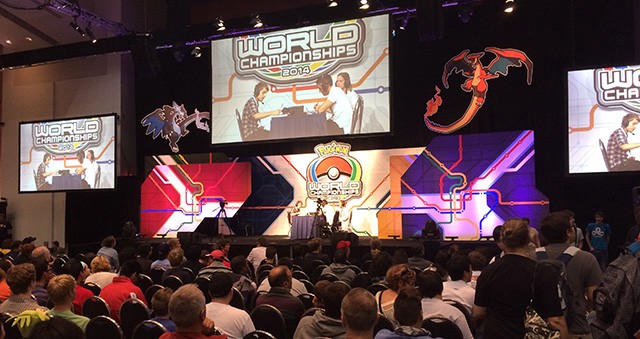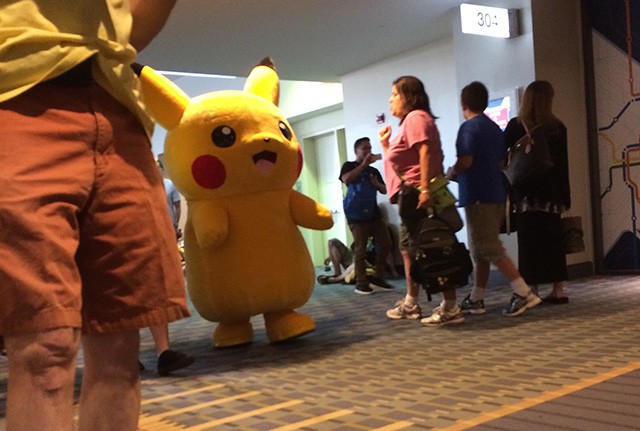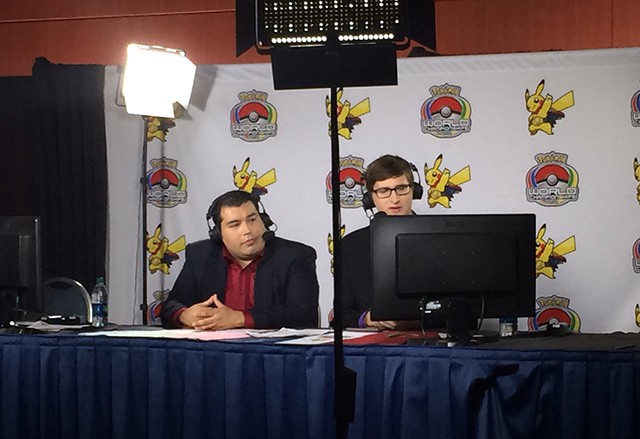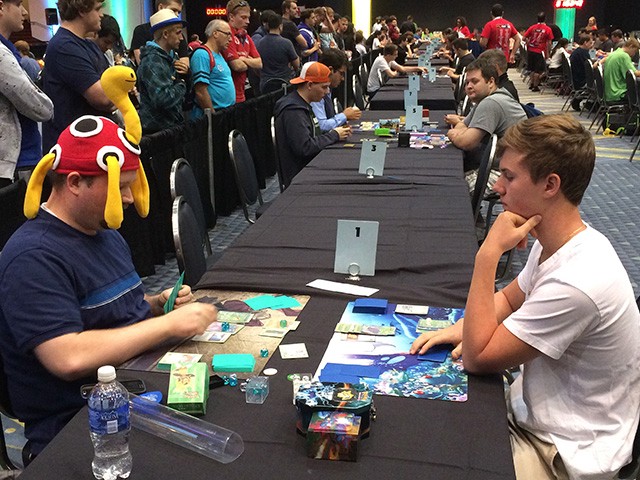Pokemon Forever
by Jeremy Gordon

Daniel Altavilla insisted that he’s a fierce competitor. The seventeen-year-old was killing time at Chipotle before registering to compete in his sixth Pokemon World Championships — his first in the tournament’s Masters division, which is the NFL of competitive Pokemon play. “A lot of players back in Florida that I play with don’t really see me as much of a threat, you know?” he told me the day before the tournament began. “A lot of these guys watched me grow up for ten years and still think of me as the kid I was. I want them to realize that I’m not just this bad little kid anymore.”
Altavilla is one of hundreds of players who traveled to Washington, D.C., to compete in the annual trading card tournament, which carried a top prize of ten thousand dollars, automatic entrance into next year’s tournament, and a year’s supply of cards. The tournament was one of the primary attractions of the Pokemon World Championships, three days of uncut celebration of the nearly twenty-year-old franchise, during which the Walter E. Washington Convention Center was transformed into a playground for thousands of Pokemon fans from Japan, Portugal, France, Australia, Canada, and two dozen other countries around the world. The moment I stepped off the escalator leading to the top of the convention center, I was bombarded with Poke-madness: Giant Pikachus and other creatures tottered around as children tested their velvety exteriors and teens posed with them for selfies; in a retail area where the wait to get in was up to two hours long, fans bought exclusive thirty-five-dollar Pokemon dolls and twenty-one-dollar Pikachu-emblazoned iPhone cases; infinitely replenished lines lead to tables where the CEO and president of the Pokemon Company, the Nintendo affiliate that runs the tournament, patiently signed autographs; preschoolers gathered in a classroom-sized makeshift theater that screened episodes of the original television show, resting peacefully on bean bags with their parents; and opportunistic adults and their teen wards advertised binders of cards up for bartering (they’re not allowed to accept money).
Game or toy-based pop culture crazes rarely sustain themselves indefinitely. Typically, a hit show, toy line, or video game materializes and becomes an infectious hit, attracting millions of fans and inspiring semi-incredulous “Today Show” segments. The fade sets in as the brand and its fans age — they get into girls, or perhaps lacrosse. Then the brand eventually dies or, at best, goes into a period of deep hibernation until an inevitably gritty Michael Bay “reimagining.” As someone who aged out of Pokemon when Y2K was still a threat, it was a shock to see so many people engaging so passionately with a cultural phenomenon that launched during the Clinton administration.

The Pokemon video game was released in Japan in 1996 and came to America two years later. It was followed by an anime television series that crafted a fictional storyline around the game mechanics. “Pokemon” translates to “pocket monsters,” which explains the central concept — Pokemon are pets with powers who are trained to fight each other, but in the name of friendship. In the original video game, you play a nameless tween — most kids used their own name — who set out into the world of Pokemon, ready to train, battle and capture the best Pokemon, defeating numerous rivals along the way. (Hence the ubiquitous catch phrase: “Gotta catch ’em all!”) The tie-in show, which was dubbed in English and exported to America, grafted a vibrantly Japanese sensibility onto the personality-less video game. Millions of children followed the adventures of Ash Ketchum, a precocious ten-year-old who left home with nothing but his sidekick Pikachu and the will to become the greatest Pokemaster that ever lived. He made human friends along the way, but most importantly, he made friends with his Pokemon — a thrilling concept for any kid who wished they could talk to their pet dogs.
After watching a few episodes of the anime, my friends and I begged our parents for Game Boys and copies of the game. For a few years in middle school, I was even a member of the game’s worldwide competitive scene, chatting with players over AIM about which tactics worked the best, which Pokemon were worth training on my Game Boy and which personal commitments I’d ignored to keep playing. (Apologies to the foreign exchange student who once watched me compete in most of an online tournament; I forgive you for trying to email me a virus upon returning home.) If I wasn’t one of the best players my age, I was at least on a first-name basis with the best players. But when I hit high school, I began to feel like staying so invested in Pokemon was a bit embarrassing and stopped playing.
After the first generation of players mostly aged out, like me, Pokemon endured as both a multi-platform franchise. Revised editions of the video games, card games, and television shows continue to be released. The most recent game, Pokemon X & Y, the sixth generation, came out last year and became the series’ most successful edition yet, selling more than twelve million copies to date. More importantly, it has remained a cultural touchstone: For its April Fools’ joke, Google added hundreds of miniature Pokemon to its Maps app and invited users to “catch ’em all,” while One Direction and MMA star Ronda Rousey have touted their attachment to the handheld games. This past spring, thousands of fans collaborated on a playthrough of the original Pokemon Gameboy game on the video streaming site Twitch. To the millennial generation, Pokemon is a pop culture experience as resonant as the Transformers or the Teenage Mutant Ninja Turtles for the generation before — something that sparks a nostalgic glimmer of recognition and, as noted, carries a built-in audience for that inevitable relaunch. But for the people here, Pokemon is clearly something more.

The Pokemon card game was introduced to the United States in December of 1998, just a few months after the video game. It offered another inexhaustible collectible element: hundreds of cards, along with a pointedly competitive dynamic: While the video game could be played in solitude, you needed two people to play the card game. No one at my school actually played it, though — they just traded cards based off what was supposed to be the rarest or coolest card. Even after the novelty of collectability wore off for casual fans, the allure of the competitive card game slowly grew for the franchise’s most ardent fans: Between 2006 and 2014, the number of players competing at the Worlds tournament has risen by a third. New card sets continue to be released every year, engendering a constant shift in the strategies and rules. This means that as soon as one has mastered one style of play, he must immediately learn another, making the study of Pokemon cards a constant endeavor.
The card game largely replicates the concept of the video game: The goal is to defeat your opponent’s team of Pokemon. At any given moment, a player may have up to six Pokemon on the table, and no fewer than one. There are three ways to win: When your opponent runs out of Pokemon; when you’ve collected six “prize” cards that are earned by defeating your opponent’s Pokemon; or when your opponent has simply run out of cards (each deck has sixty). Each Pokemon has a set of moves that are activated by attaching a certain number of “energy cards” — a weak attack might require one energy, while a strong one might require four. Roughly speaking, the goal is to draw the proper cards so that your Pokemon can attack, and drain the other player’s card of health points. Every player’s deck has a specific strategy, but only luck enables him or her to execute those strategies.
Being “elite” doesn’t just mean having the best cards, or the best strategy; It means being able to see the game a few turns ahead, and understanding when to strike — or, just as importantly, bide one’s time. It’s also intuition, bred from hundreds of hours running through scenarios, every contingency and stroke of luck accounted for; it’s the difference between a guy at your local Y, and LeBron James. This requires dedication, and players sometimes struggle for years to wrap their head around how to see the game at the highest level.
Players qualify for the World Championships, which take place over three days, by collecting hundreds of “championship points” at lower-level tournaments around the world during the preceding year; it’s sort of like tennis, where the quality of one’s play year round determines who is invited to the biggest tournaments. On Saturday, the competitors gathered at around 9 A.M. to play nine rounds of what’s called the “Swiss” format — they were given fifty minutes to play a best-of-three, with only complete matches counting toward their final score. (This means that if the players split the first two matches and run out of time to finish the third, it’s scored as a tie.) When the rounds were finished nearly twelve hours later, their records were assigned corresponding point values, with the top eight players making the “final cut” to play in a single-elimination bracket on Sunday to determine the champion. This meant that the bulk of play occurs on Saturday, swiftly validating — or mercilessly undoing — a long year of competitive play in a single day.

The biggest matches were broadcast on a wall-sized screen hanging in the middle of a football field-sized room, with rows of chairs set up for hundreds of fans to sit in and spectate. The competitors walked out to exuberant EDM music, pumping their fists and waving at their flag-bearing countrymen. They sat opposite each other, their cards laid out like tarot readings, and took turns moving these cards around the table so quickly that, watching from a distance, I could only register colors and words. A pair of commentators narrated and explained the action for casual fans: This player needed that card on this turn for his strategy to come together. When a necessary card was drawn, the crowd’s roar was immediate. Standing at the posted list of upcoming games, a group of pudgy tweens rattled off the names of players they wanted to watch with the glee of someone pointing out Derek Jeter across the street. At one point I saw Jason Klaczynski, the baby-faced three-time world champion whose winning deck from last year you can purchase through the Pokemon Company, autographing cards for a fan.
Apart from the main event, there’s something called the “last chance qualifier” — a single-elimination tournament comprising hundreds of players who can get in by surviving several rounds against each other. A pair of friends named Robert and Jonathan drove from Cincinnati to compete; they only had disparaging things to say about their own skills, yet retained the hope that they’d perform well enough to play in the big time. (When I saw them and asked how it went, Robert told me, “We both got wrecked.”) One player in the main event, Robby Weidemann, told me that he won the last chance qualifier a couple of years ago after flying from New Jersey to Hawaii, where the tournament was then being held.

Even for the players who’d begun the weekend with hopes of winning it all and quickly realized they wouldn’t, there was always a silver lining. Paul Johnston, a body builder, had returned to competition after college forced him into a four-year hiatus, during which he’d occasionally attended smaller tournaments with friends and borrowed their decks to compete here and there. He began the tournament with a loss and a tie, and knew he would have to win the rest of his matches to make the final cut. Despite the unfavorable odds, he finished out the day, and placed sixty-sixth out of a hundred and seventy-seven. (The smallest prizes, such as packs of cards, are first awarded to players who place at sixty-four and above.) “It was just good to get back in the game and be part of Worlds,” he told me. “I’m really proud of myself for making it.”
After a middling start, Michael Diaz, an eleven-year veteran and upcoming college freshman, decided to take the rest of the day off to hang out with his friends in and around the convention center. “I just wasn’t having a good time anymore. I really didn’t want to play Pokemon anymore, is what it comes down to,” he says. “I had no incentive to stay anyways, so I just went and got food with friends and forgot about it. Obviously it didn’t go as well as it could have but I had a good time seeing everyone again.”
Some players got what they were looking for, or something close to it. Altavilla started with two wins and two ties, and quickly realized he was playing well enough to possibly earn himself a final berth. “I came across one difficult situation, and someone who plays differently than me might not have noticed how to get it,” he told me. “The way I went about it made me feel confident — like I’m piloting this deck, and I can pilot it to different standards than most.” He then won four more games, and lost only one, putting him within reach of the top eight, but, because of a tiebreaker, which is determined by the winning record of opponents, he placed an agonizingly close ninth. “I thought I’d made it, and I looked and it was the most shocking thing ever,” he says. “I just missed. I was shocked for a bit and I couldn’t really speak or anything.”
After the initial shock, the reality of success set in: Although Altavilla didn’t play in the final, single-elimination bracket, he was the top American player. (Above him were three players from Portugal, two players from Canada, two players from France and one player from Japan.) Afterwards, he and his friends celebrated at Hooters; even his father, a former football coach, praised Altavilla for how far he’d made it. “It sucks because I didn’t make the top eight but it’s nothing to scoff at,” he said. “Now people are going to see my name and go, ‘Whoa, it’s that kid.’ Even if they see me as the kid who only missed it by one spot, they’ll still know who I am and that’s pretty cool.”
There are a lot of reasons why Pokemon has endured, but one of the biggest has to do with how community is encouraged within the game itself. In the game’s fictional storyline, the importance of becoming friends with your Pokemon is continually stressed from the beginning, so that when you meet another Pokemon fan in real life, it’s easy to find something to talk about because you already have so many friends in common.
During the final, which was between Canada’s Andrew Estrada and Portugal’s Igor Costa, several of the players I interviewed — and many more I didn’t — watched with the casual interest of NBA players sitting courtside at the Dunk contest. Their attention was held, for now at least. Before the tournament, the players talked about the spouses they hope to meet, the classes about to begin. The time to attend tournaments every other weekend will shrink. But after spending this much time with Pokemon, it will be hard to step away for good.
Jeremy Gordon is a staff writer for Pitchfork who lives in Brooklyn and plays games for children.
